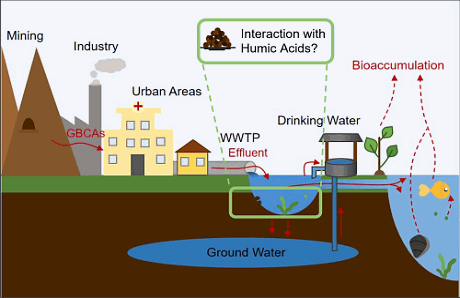Researchers from the University of Münster have studied the interaction of gadolinium-based contrast agents (GBCAs) with humic acids as potential binding partners in the aquatic environment. Speciation analysis by size exclusion chromatography-UV-ICP-MS confirmed that Gd-humic acid adducts were formed in case of the linear gadodiamide, but not with the macrocyclic gadobutrol.
Background:Gadolinium-based contrast agents are used in about every second medical magnetic resonance imaging (MRI) for improving the image quality. About 25,000,000 patients per year are investigated by this diagnostic tool, each one receiving typically around 1.2 g of gadolinium. Most of the Gd is excreted unmetabolized by the patients within the first day after application, with urine entering the environment via waste water. Only about 10% of the gadolinium released into the waste water resulting from its use as MRI contrast agent is removed from the waste water stream. Therefore, intact GBCAs have been found in several surface waters, from the rivers receiving the outlet of the waste water plants to the coastal sea. Also, the uptake in plants and aquatic organisms has been observed. In order to understand the fate of these compounds in the environment, their transport within soils and sediments and their long term behaviour, there is a need to study their reactions with potential binding partners.

Figure 1: Overview of potential distribution and accumulation pathways of GBCAs in the environment
Researchers from the University of Münster now investigated humic substances as potential binding partners for GBCAs. These compounds are an important part of soil organic matter and due to their polyelectrolytic character can bind different metal ions, influencing their mobility in the environment. For their investigation, the researchers performed model experiments both with a linear (gadodiamide) and a macrocyclic GBCA (gadobutrol). After incubation with humic acid, the macromolecular fraction was separated by ultra-centrifugation and analysed for its Gd content by ICP-MS. The result of the experiment clearly showed a different reaction behaviour for the two types of GBCAs. While 73% of the Gd from the linear GBCA was found in the macromolecular fraction, only 0.41% Gd from the macrocyclic GBCA was found in this fraction.
A further speciation analysis of the macromolecular fraction by size exclusion chromatography-UV-ICP-MS confirmed that Gd-humic acids adducts were formed in case of linear gadodiamide, but not with the macrocyclic gadobutrol. The high adduct formation rate for the linear gadodiamide can potentially lead to the subsequent uptake of toxic Gd3+ into aquatic organisms.
The authors concluded that more GBCAs should be investigated in order to learn whether their findings can be generalized for all linear and macrocyclic compounds. In addition, since the application of macrocyclic GBCAs has increased over the years, the question of their accumulation in the aqueous environment is raised. Further studies with other potential reaction partners are required to complete the picture of their environmental behaviour.
 The original study
The original study
 Instrumentation used:
Instrumentation used: Related studies (newest first)
Related studies (newest first)
M. Horstmann, R. Gonzalez De Vega, D.P. Bishop,
U. Karst, P.A. Doble,
D. Clases,
Determination of gadolinium MRI contrast agents in fresh and oceanic waters of Australia employing micro-solid phase extraction, HILIC-ICP-MS and bandpass mass filtering. J. Anal. At. Spectrom. 36 (2021) 767–775.
DOI: 10.1039/d0ja00493f
J. Wahsner, E.M. Gale, A. Rodríguez-Rodríguez, P. Caravan,
Chemistry of MRI contrast agents: current challenges and new frontiers. Chem. Rev. 119 (2019) 957–1057.
DOI: 10.1021/acs.chemrev.8b00363.

M. Birka,
C.A. Wehe, O. Hachmöller,
M. Sperling,
U. Karst, Tracing gadolinium-based contrast agents from surface water to drinking water by means of speciation analysis. J. Chromatogr. A 1440 (2016) 105–111.
DOI: 10.1016/j.chroma.2016.02.050.

H. Matsumiya, H. Inoue, M. Hiraide,
Separation of Gd-humic complexes and Gdbased magnetic resonance imaging contrast agent in river water with QAE-Sephadex A-25 for the fractionation analysis. Talanta 128 (2014) 500–504.
DOI: 10.1016/j.talanta.2014.06.005
M. Birka,
C.A. Wehe,
L. Telgmann,
M. Sperling,
U. Karst, Sensitive quantification of gadolinium-based magnetic resonance imaging contrast agents in surface waters using hydrophilic interaction liquid chromatography and inductively coupled plasma sector field mass spectrometry. J. Chromatogr. A 1308 (2013) 125–131.
DOI: 10.1016/j.chroma.2013.08.017.

P. Boguta, Z. Sokolowska,
Interactions of humic acids with metals.
Acta Agrophys. Monogr., 2013/2 (2013) 1-113.  L. Telgmann
L. Telgmann,
C.A. Wehe, M. Birka, J. Künnemeyer, S. Nowak,
M. Sperling, U. Karst, Speciation and isotope dilution analysis of gadolinium-based contrast agents in wastewater. Environ. Sci. Technol. 46 (2012) 11929–11936.
DOI: 10.1021/es301981z.
 R. Kautenburger, Influence of metal concentration and the presence of competing cations on europium and gadolinium speciation with humic acid analysed by CE-ICPMS.
R. Kautenburger, Influence of metal concentration and the presence of competing cations on europium and gadolinium speciation with humic acid analysed by CE-ICPMS. J. Anal. At. Spectrom. 24 (2009) 934–938.
DOI: 10.1039/b904107a R. Kautenburger,
R. Kautenburger, K. Nowotka, H.P. Beck,
Online analysis of europium and gadolinium species complexed or uncomplexed with humic acid by capillary electrophoresis-inductively coupled plasma mass spectrometry. Anal. Bioanal. Chem. 384 (2006) 1416–1422.
DOI: 10.1007/s00216-006-0299-3.
 Related EVISA News
Related EVISA News
last time modified: September 18, 2024